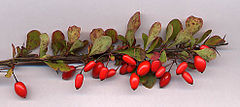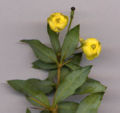Berberis
| Berberis | |
|---|---|

| |
| Berberis darwinii shoot with flowers | |

| |
| Berberis thunbergii shoot with fruit | |
| Scientific classification | |
| Kingdom: | |
| Division: | |
| Class: | |
| Order: | |
| Family: | |
| Genus: | Berberis |
| Species | |
|
About 450-500; see text | |
Berberis (/[invalid input: 'icon']ˈbɜːrbərɪs/ Bér-be-ris) is a genus of about 450-500 species of deciduous and evergreen shrubs from 1-5 m tall with thorny shoots, found throughout the temperate and subtropical regions of the world (apart from Australia). Species diversity is greatest in South America, Africa and Asia; Europe has a few species, and North America two. The most well-known Berberis species is the so-called European barberry, Berberis vulgaris, which is common in Europe, North Africa, the Middle East, and central Asia.
The plant
The genus Berberis is characterised by dimorphic shoots, with long shoots which form the structure of the plant, and short shoots only 1-2 mm long. The leaves on long shoots are non-photosynthetic, developed into three-spined thorns 3-30 mm long; the bud in the axil of each thorn-leaf then develops a short shoot with several normal, photosynthetic leaves. These leaves are 1-10 cm long, simple, and either entire, or with spiny margins. Only on young seedlings do leaves develop on the long shoots, with the adult foliage style developing after the young plant is 1-2 years old.
Many deciduous species, such as Berberis thunbergii or B. vulgaris, are noted for their attractive pink or red autumn colour. In some evergreen species from China, such as B. candidula or B. verruculosa, the leaves are brilliant white beneath, a feature valued horticulturally. Some horticultural variants of B. thunbergii have dark red to violet foliage.
The flowers are produced singly or in racemes of up to 20 on a single flower-head. They are yellow or orange, 3-6 mm long, with six sepals and six petals in alternating whorls of three, the sepals usually coloured like the petals. The fruit is a small berry 5-15 mm long, ripening red or dark blue, often with a pink or violet waxy surface bloom; in some species, they may be either long and narrow, but are spherical in other species.
The genus Berberis is closely related to the genus Mahonia, which is included within Berberis by some botanists.
Ecology
Berberis species are used as food plants by the larvae of some Lepidoptera species, including a moth, the Mottled Pug.
Berberis vulgaris (European barberry) and Berberis canadensis (American barberry) serve as alternate host species of the wheat rust fungus (Puccinia graminis), a grass-infecting rust fungus that is a serious fungal disease of wheat and related grains. For this reason, cultivation of B. vulgaris is prohibited in many areas, and imports to the United States are forbidden. The North American B. canadensis, native to Appalachia and the Midwest United States, was nearly eradicated for this reason, and is now rarely seen extant, with the most remaining occurrences in the Virginia mountains.
Some Berberis species have become invasive when planted outside of their native ranges, including B. glaucocarpa and B. darwinii in New Zealand (where it is now banned from sale and propagation), and green-leaved B. thunbergii in much of the eastern United States.
Cultivation
Several species of Berberis are popular garden shrubs, grown for such features as ornamental leaves, yellow flowers, or red or blue-black berries. Numerous cultivars and hybrids have been selected for garden use. Low-growing Berberis plants are also commonly planted as pedestrian barriers. Taller-growing species are valued for crime prevention; being very dense, viciously spiny shrubs, they make very effective barriers impenetrable to burglars. For this reason they are often planted below potentially vulnerable windows, and used as hedges.
Species in cultivation include:-
The following hybrid selections have gained the Royal Horticultural Society's Award of Garden Merit:-
- B. 'Georgei'[1]
- B. x lologensis 'Apricot Queen'[2]
- B. x media 'Red Jewel'[3]
- B. x ottawensis f. purpurea 'Superba'[4]
- B. x stenophylla 'Corallina Compacta'[5]
- B. x stenophylla Lindl (golden barberry)[6]
Culinary uses
Berberis vulgaris grows in the wild in much of Europe and West Asia. It produces large crops of edible berries, rich in vitamin C, but with a sharp acid flavour. In Europe for many centuries the berries were used for culinary purposes in ways comparable to how citrus peel might be used. Today in Europe they are very little used. The country in which they are used the most frequently today is Iran. In Iran the berries are common in rice pilafs and as a flavouring for poultry meat.
Berberis microphylla or the similar B. heterophylla (both known as Calafate), and B. darwinii (Michay) are two species found in Patagonia in Argentina and Chile. Their edible purple fruits are used for jams and infusions; anyone who tries a berry is said to be certain to return to Patagonia. The calafate and michay are symbols of Patagonia.
Traditional medicine
The dried fruit of Berberis vulgaris is used in herbal medicine.[7] The active ingredients are thought to be the isoquinolone alkaloids, especially berberine. For more info see berberine. A new study from the Natural Medicine Journal shows that it is superior to Metformin in treating poly-cystic ovarian syndrome. [8]
Other uses
Historically, yellow dye was extracted from the stem, root, and bark.[9]
Selected species
Gallery
-
Berberis aggregata, fruits.
-
Berberis aristata, from the Himalayas
-
Berberis gagnepainii, with three-spined thorn (modified long shoot leaf) with leafy short shoot. Each thorn is 20 mm long.
-
Berberis gagnepainii, flower detail (flowers 7 mm diameter).
-
Berberis gagnepainii, fruit.
-
Berberis harrisoniana, from southwestern Arizona
-
Berberis thunbergii, shrub.
-
Berberis valdiviana, flowers, from Chile (cultivated at Birmingham Botanical Gardens)
-
Berberis verruculosa, upper side of shoot above, lower side below.
-
Berberis vulgaris, flowers and foliage, cultivated in Denmark
References
- ^ http://apps.rhs.org.uk/plantselector/plant?plantid=2170
- ^ http://apps.rhs.org.uk/plantselector/plant?plantid=5708
- ^ http://apps.rhs.org.uk/plantselector/plant?plantid=2173
- ^ http://apps.rhs.org.uk/plantselector/plant?plantid=2174
- ^ http://apps.rhs.org.uk/plantselector/plant?plantid=2175
- ^ http://apps.rhs.org.uk/plantselector/plant?plantid=238
- ^ See e.g. "Barberry" @ Alternative Medicine @ University of Maryland Medical Center. See also Berberine at Wikipedia.
- ^ http://naturalmedicinejournal.com/article_content.asp?edition=1§ion=3&article=387
- ^ Tomlinson, C., ed. (1866). Tomlinson's Cyclopaedia of Useful Arts. London: Virtue & Co.
{{cite book}}:|author=has generic name (help)CS1 maint: multiple names: authors list (link) Vol I, page 97.
- Murrills, Angela (2005-11-24). "Best Eating: Check, please". Straight.com. Retrieved 2007-05-02.
{{cite web}}: Cite has empty unknown parameter:|coauthors=(help)
- Wilkinson, Bobbie (2004-08-15). "It's an Adventure in Persian Cuisine at Darya Kabob". The Washington Post. Retrieved 2007-05-02.
{{cite web}}: Unknown parameter|coauthors=ignored (|author=suggested) (help)
- Arellano, Gustavo (2004-03-18). "Naan & Kabob". Orange County Weekly. Retrieved 2007-05-02.
{{cite web}}: Cite has empty unknown parameter:|coauthors=(help) - Royal New Zealand Institute of horticulture. Berberis glaucocarpa










